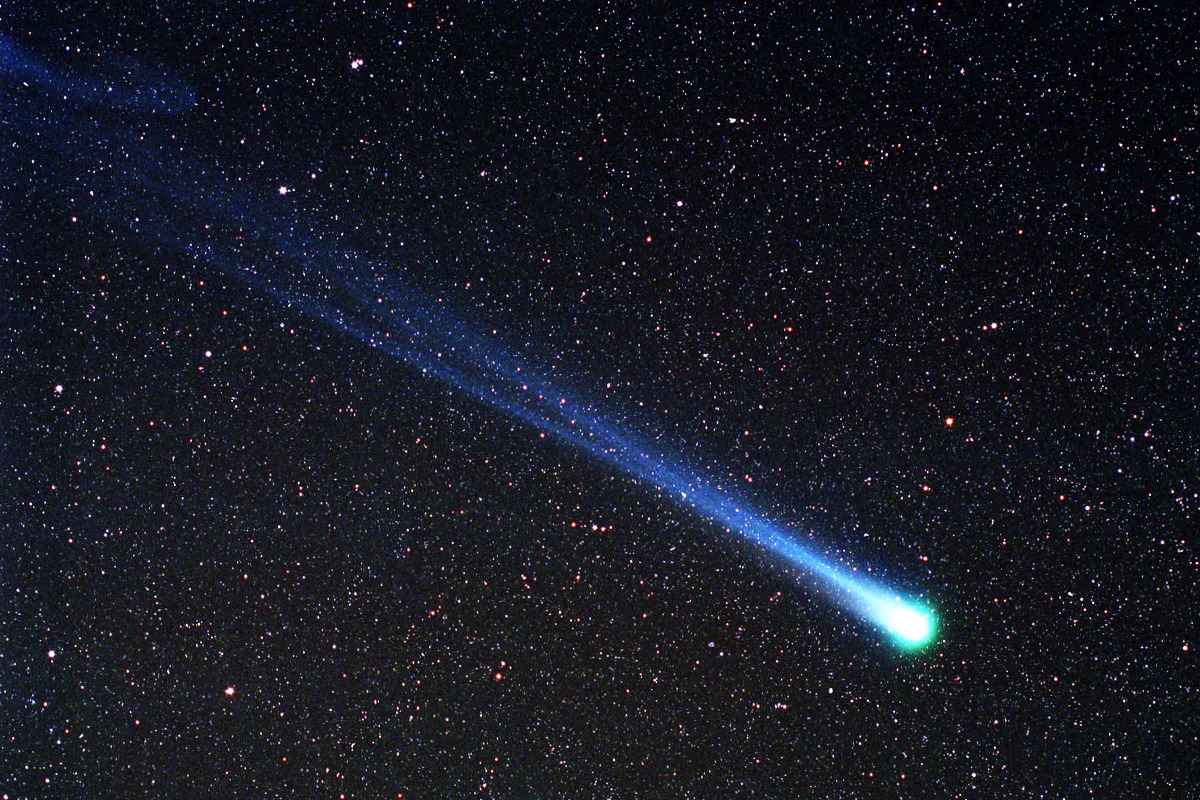Comet Tales
Comet 2022 E3 ZTF is passing through the inner Solar System now.
Near the end of this blog there’s a finder chart to help you see this cosmic visitor.
This set me thinking about comets I have been lucky enough to see.
I have chosen four of the best to tell my comet tales.
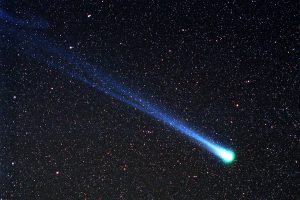
Comet Hyakutake NASA
Origin & Nature of Comets
Comets are dust-covered icebergs that orbit our Sun at huge distances.
The great comet scientist Fred Whipple called them ‘dirty snowballs’.
They are city-sized blocks of ice covered in rocks and dust.
Most are around 20km across.
Comets come from the outer reaches of the Solar System.
At the edge of our planetary system is a vast sphere occupied by comets.
It is the Oort Cloud, named after the Dutch astronomer Jan Oort.
This solar envelope contains millions of comets.
The cloud spreads out from 1000 to 100,000 times the distance of the Sun.
There is also an inner zone of comets, the Kuiper Belt.
This disc spreads from 30 to 50 times the distance of Earth from the Sun.

Oort Cloud & Kuiper Belt, logarithmic scale. NASA/JPL Caltech
Now let’s take a look at comets I have seen.
Halley’s Comet
I saw the most famous of all comets as it passed us in 1986.
Because of its position, it was not a bright object.
In the light-polluted skies of Sheffield, a telescope was required to see it properly.
Observations of Halley’s comet
The comet’s 1986 appearance was the worst on record.
Wouldn’t you know it!
Halley and Earth were on different sides of the Sun.
At that distance, the comet appeared dim.
In a dark sky you could see it as a fuzzy glow.
Binoculars or a telescope were needed for a proper look.
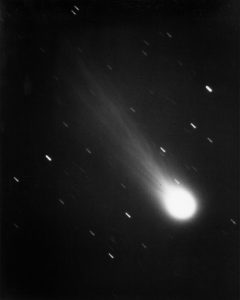
Halley’s Comet 1986 NASA
As far as I can recall, Halley had a bright head (the coma) and a short tail.
The tail spread out into a fan shape.
Although the view was rather underwhelming, it was exciting to see the most famous comet of all.
For most people, it is a once-in-a-lifetime event.
Giotto
Despite Halley’s unfavourable position, a fleet of spacecraft were launched to take a close look.
Most notable was the European Space Agency’s Giotto probe.
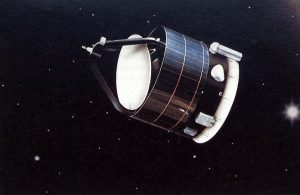
Giotto probe Credit: ESA
On March 14th, 1986, Giotto made its closest approach to Halley.
It flew within 600km (370 miles) of the nucleus.
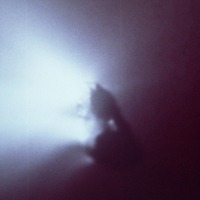
Halley’s nucleus from Giotto. ESA
It was the first time we had seen the nucleus of a comet.
The peanut shaped iceberg was dark, covered in dust.
Bright active areas were clearly visible.
Halley’s nucleus measured around 15 x 10 km, about 9 x 6 miles.
This is remarkably small for an object which has been so spectacularly bright in the past.
Halley’s Return
This year, December 2023, sees Halley reach its furthest point from the Sun, aphelion.
So from 2024 onwards, Halley will be on its long journey inwards towards the Sun – and our Earth.
Comet Halley will return to our sky in 2061.
This time it will be much better placed so it will look much brighter.
I hope that you see it!
If you do, give it a wave for me.
Comet Hyakatake
The 1990s were blessed with two bright comets.
In 1996 came Hyakutake.
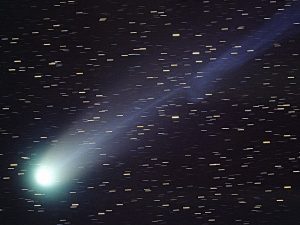
Comet Hyakutake
Kolmhofer, H. Raab; Johannes-Kepler-Observatory, Linz, Austria
It was discovered in January 1996.
The finder was Japanese amateur astronomer, Yuji Hyakutake.
By the end of March the comet was among the brightest objects in the night sky.
Its tail stretched across the stars.
The tail was a electric blue, whilst the head of the comet glowed distinctly green.
For a few days Hyakutake was a brilliant sight.
Then it moved rapidly away from earth and dimmed out of sight.
The comet may return – in around 70,000 years!
Comet Hale-Bopp
Hyakutake proved to be just the appetizer for the main course.
In 1997, Comet Hale-Bopp lit up our skies.
The comet was discovered independently in July 1995 by Alan Hale and Thomas Bopp in the USA.
It brightened through 1996 but was still only visible through a telescope.
That all changed in 1997 as it neared the Sun.
By April 1997 it was at its closest point to the Sun, perihelion.
Now it could be seen before the sky was dark.
It was visible all night, a spectacular object among the stars.
Hale-Bopp had two distinct tails.
The gas tail was blue whilst the dust tail glowed pale yellow.
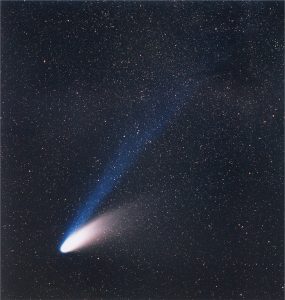
Comet Hale-Bopp. Credit: ESO / E. Slawick
Hale-Bopp shone brightly in the sky for weeks.
Through Star Centre at Sheffield Hallam University, I helped organise public viewings.
Over three nights, several hundred people joined us to see the comet in the dark skies of Derbyshire.
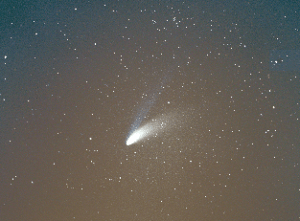
Hale-Bopp from Sheffield, 1997. Photo: Dennis Ashton
Hale-Bopp was a large comet. Its nucleus was around 60km across.
Its favourable position at perihelion combined with its size made Hale-Bopp a record-breaking comet.
It was visible without optical aid for 18 months.
Hale-Bopp became the most observed comet in history.
Comet Neowise
Since 1997 I have patiently waited for another bright comet.
None have turned up so far.
The brightest since Hale-Bopp was Comet Neowise.
Its slightly odd name comes from its discoverer.
Not a person but a telescope, the Wide-field Infrared Explorer (WISE) space telescope.
Neowise brightened to naked eye visibility.
In July 2020, I saw the comet low in the western sky at dusk.
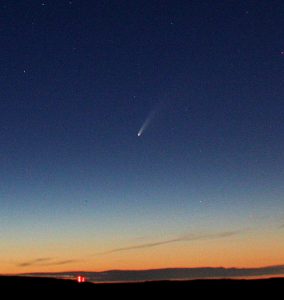
Comet Neowise. Photo: Dennis Ashton
The comet nucleus was about 5km across, similar to Hyakutake.
It showed both a blue gas tail and golden dust tail.
In the twilight near Sheffield, I saw only the bright dust tail.
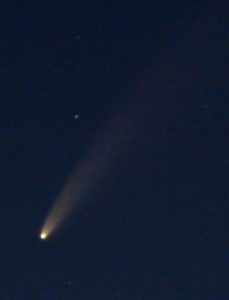
Comet Neowise. Photo: Dennis Ashton
Comet 2022 E3 ZTF
Comet 2022 E3 ZTF will be at its brightest in the final days of January and the early days of February this year.
At its peak brightness it might be just visible with the naked eye.
However it is more likely you will need binoculars to pick it out in a dark sky.
It will appear as a fuzzy glow, with only a vestige of a tail.
Our finder chart shows where to look for Comet 2022 E3 ZTF.
Look north and find the Big Dipper.
Use a line from the end two stars of the Dipper to the North Star, Polaris.
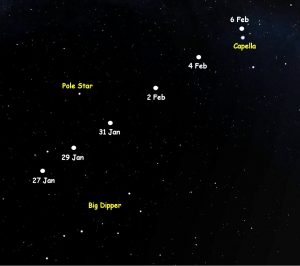
Path of Comet E3 ZTF. Dennis Ashton / Stellarium
In late January the comet will pass between the Dipper and Polaris.
By early February the comet lies between Polaris and the bright yellow star Capella.
By February 6th it is just above Capella.
The comet’s name, E3 ZTF, shows that it was discovered in March 2022 at the Zwicky Transient Facility.
The ZTF is located at Mount Palomar in California.
The next great comet
When will the next great comet light up our skies?
Sadly no-one knows.
Several comets pass through the inner solar system each year.
They go almost unnoticed, visible only as smudges of light in telescopes.
The next great comet will be like Hale-Bopp.
It will have a large nucleus, a big space iceberg.
Huge gas and dust tails will develop as it flies close to the Sun.
It’s favourable position to earth will make it a spectacular sight.
Comets may take a million years to travel from the outer limits of the Solar System.
We don’t know when the next spectacular comet will arrive.
But we do know that it’s on its way!
The author: Dennis Ashton is a Fellow of the Royal Astronomical Society and a Wonderdome presenter.
Would you like to hear more Astronomy news?
Do you want to to find out about our upcoming public events?
Follow WonderDome Portable Planetarium on Twitter and Facebook or go to our web site wonderdome.co.uk

